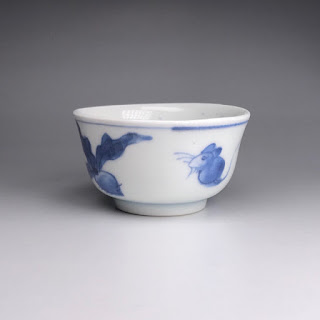染付 鼠と大根 Mouse and Radish
19世紀 19c
幅 width 72 mm / 高さ height 40 mm
器は厚ぼったく、高台のつくりもやや稚拙であるが、絵付けは手慣れた感じで、とくに二股大根の絵はダイナミックですばらしい。ねずみは子沢山で、子孫繁栄の象徴。ダイコンがダンコンに通ずるのかどうかわからないが、太い根っこは生命の活力に満ちている。古くから二股大根は大黒様にお供えする、って辞書に書いてあった。ともかく縁起のいい猪口である。
骨董屋によると、これは正確には古伊万里ではなく、江戸時代の平戸系のやきものらしい。江戸時代の有田焼を古伊万里と呼ぶ。積出港が伊万里だっだから、と言われる。とくに当地を治めていた佐賀(鍋島)藩の御用窯の製品を鍋島焼という。いっぽう、おとなり平戸藩にも磁器の産地があり、これを平戸焼という。とくに三川内(みかわち)焼が有名である。有田から佐世保方面に 10 km ちょっとのところに窯があり、平戸藩の御用窯であった。あのあたりにはほかにも波佐見焼とか、志田焼とか、やきものの産地がたくさんあり、総称して肥前磁器という。
この猪口は、上手の古伊万里などにくらべると器が厚ぼったく、白磁の色も白っぽい。これはこの産地の陶土が有田とは違うからとも考えられる。粘りがないので薄く造るのが困難だったのかもしれない。ただ正確な産地は、わたしのような浅学者にはわからない。
The body is thick and the foot is not very good, but the painting is skillful; especially the radish of a shape like a fork. Mouse is a symbol of prosperity because of large family. I’m not sure if radish (daikon) has relation to penis (dankon), but the big root gives an impression of vigor. Anyway, this is a cup of good fortune.
According to the shop's owner, this is not an Imari cup, but was produced in Hirado. Old Imari ware means porcelain made in Arita in Edo period. Arita is a town in Saga. Hirado was a next feudal domain and there were several places where porcelain was produced.


